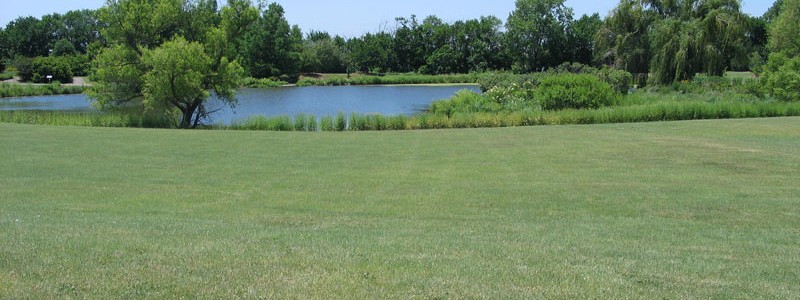Chances are, if you have a question, other people are wondering about the same thing. So, we developed a list of commonly asked questions and answers and categorized them so you can quickly find the information you are looking for. If you don’t find the answers you need, please contact us at (620) 327-8127.
What variety of Buffalograss is best for Kansas?
At the arboretum, you can view several kinds of buffalograss. Cody, sown from seed, is a dense-type turf that keeps weeds out and covers well the first year. Because of its short height, we mow it only several times a season. You can leave the seedheads for a natural look or mow them off for a more turf type appearance. Another seed variety, Bowie, is being trialed and results are pending. Legacy, planted with plugs, can be used in plantings where erosion could wash out a seeding. It provides a turf type look without seedheads and needs little mowing.
Will a buffalograss lawn create a thatch?
To avoid thatch build-up, Stock Seed Farms suggests using a dethatcher or mowing the grass very short in the spring and catching the clippings.
Can I plant native plants in the fall?
Our customers are buying more plants at our fall sale because they are having such good success. The plants use the warm soils of autumn to establish a vigorous root system. Come spring the plant appears with lush foliage and often bloom that first year. Fall planting gives gardeners a chance to decide what to add to their garden with the images of summer fresh in their minds. For more information on planting and maintaining your native plants, download our Water Smart – Best Management Practices for Native Plants guidelines.
Should I mulch native plants?
Spring mulching: Mulch can be applied about 1 inch thick after transplants are in the ground. If soil is kept too moist, native plants may experience root rot and die. Fall mulching: After the plants go dormant, mulch with bark, pea gravel or compost to a depth of 2 inches. Mulching keeps the soil temperature more even, reducing the effects of erratic temperature swings of the winter and spring months by keeping the soil frozen, reducing water loss, and reducing frost heaving. Mulching large plantings (over 1000 sq. ft.) it is usually cost prohibitive and very labor intensive. Most large prairie plantings will be able to survive with no mulching.
How early in the spring should I plant natives?
Native plants do best when planted when soil temperatures are warm. We schedule our FloraKansas plant sale in late April when planting is optimal for the next several weeks.
How long will it take to establish this natural landscape?
Establishment of a natural garden using transplants can have immediate results. Wildflowers and grass planted in the fall call produce blooms the next year. It will still take them these newly established plants several years to get fully rooted.
When establishing plants from seed it usually takes 3-5 years to get a natural landscape to begin to bloom and the grasses to get fully established. There are prairies established 20-30 years ago that are just now reaching maturity. These prairies have the diversity and complexity of an original non-disturbed prairie. It takes many years to develop the extensive root system needed to survive on the Great Plains.
How much maintenance will I have this year and in the future?
If wildflowers and grasses are matched to the site and properly established, a natural garden should not require much maintenance. Fertilizer and pesticides are not needed and water can be used sparingly during dry spells to keep plants looking good. In spring, we remove the previous year’s growth. This can be done with a hedge trimmer or a mower. Cut growth down to two to four inches from the ground. Check for weeds throughout the year. The deep roots of the wildflowers and grasses will keep these plants resilient and growing during short dry spells and encourage dormancy instead of death during long dry spells. Watering is only needed during periods of prolonged drought.
What are the long term costs of a natural landscape?
Cost can be kept to a minimum if plants are matched to the site and properly established. Certainly, long-term costs will be less than a traditional landscape.
Do I have to burn my native and adaptable plant garden to be successful?
No, you do not need to burn a natural garden to be successful. Although burning is important to the overall success of the larger prairie ecosystem, this practice can be mimicked by removing the previous year’s growth with a hedge trimmer or mower. Small natural gardens can be burned but local fire codes need to be observed and extreme caution needs to be taken to prevent an out-of-control fire. This is not recommended unless you are working with a trained prairie burn specialist. Usually prairies less than one acre in size are mowed rather than burned.

